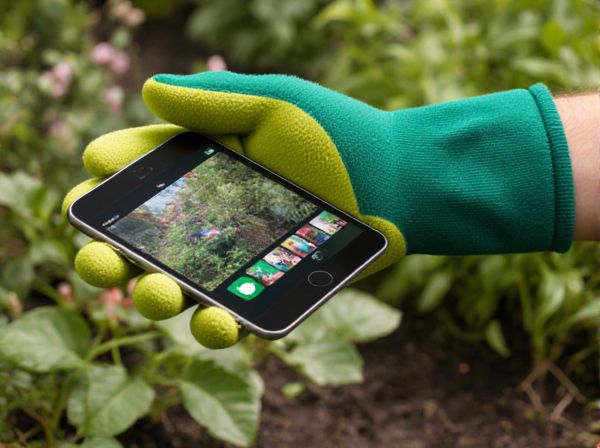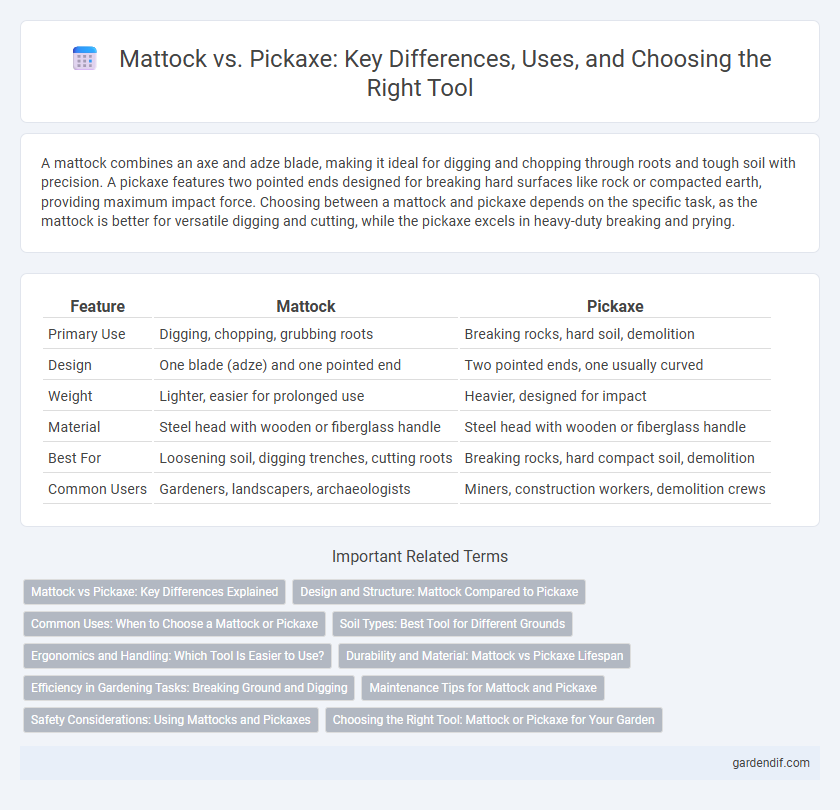
Mattock vs Pickaxe Illustration
A mattock combines an axe and adze blade, making it ideal for digging and chopping through roots and tough soil with precision. A pickaxe features two pointed ends designed for breaking hard surfaces like rock or compacted earth, providing maximum impact force. Choosing between a mattock and pickaxe depends on the specific task, as the mattock is better for versatile digging and cutting, while the pickaxe excels in heavy-duty breaking and prying.
Table of Comparison
| Feature | Mattock | Pickaxe |
|---|---|---|
| Primary Use | Digging, chopping, grubbing roots | Breaking rocks, hard soil, demolition |
| Design | One blade (adze) and one pointed end | Two pointed ends, one usually curved |
| Weight | Lighter, easier for prolonged use | Heavier, designed for impact |
| Material | Steel head with wooden or fiberglass handle | Steel head with wooden or fiberglass handle |
| Best For | Loosening soil, digging trenches, cutting roots | Breaking rocks, hard compact soil, demolition |
| Common Users | Gardeners, landscapers, archaeologists | Miners, construction workers, demolition crews |
Mattock vs Pickaxe: Key Differences Explained
Mattocks and pickaxes serve distinct functions in excavation and landscaping; a mattock combines an axe blade and adze for digging and chopping roots, while a pickaxe features pointed ends designed for breaking hard surfaces like rock and soil. The mattock's dual blades optimize versatility for tougher soil and root removal, whereas the pickaxe's sharp, narrow tips provide precision in fracturing compact ground. Choosing between a mattock and pickaxe depends on the specific task requirements, with mattocks better suited for mixed soil conditions and pickaxes excelling in heavy-duty breaking and prying applications.
Design and Structure: Mattock Compared to Pickaxe
The mattock features a dual-purpose head with an axe blade on one side and an adze on the other, optimized for digging and chopping, while the pickaxe has two pointed ends designed primarily for breaking hard surfaces like rock or concrete. Mattocks typically have a shorter, curved handle that enhances leverage and control, contrasting with the longer, straight handle of a pickaxe that aids in delivering powerful strikes. This structural difference makes the mattock more versatile for gardening and agricultural tasks, whereas the pickaxe is specialized for mining and demolition.
Common Uses: When to Choose a Mattock or Pickaxe
A mattock is ideal for digging in hard or compacted soil and chopping through roots, making it perfect for gardening and landscaping tasks. A pickaxe excels at breaking up rocky or hard surfaces like concrete and stone, often used in mining and heavy construction. Choosing a mattock or pickaxe depends on whether the primary need is soil cultivation and root removal or heavy-duty surface breaking and excavation.
Soil Types: Best Tool for Different Grounds
Mattocks excel in breaking through hard, rocky, and compacted soils due to their broad, versatile blades that combine an axe and adze for digging and chopping. Pickaxes are ideal for extremely tough, rocky terrains and frozen ground, where their pointed, narrow heads penetrate dense materials more effectively. Selecting the right tool depends on soil composition: use a mattock for mixed or clay-heavy soils and a pickaxe for stone-laden or icy surfaces.
Ergonomics and Handling: Which Tool Is Easier to Use?
Mattocks feature a curved blade and a longer handle designed for improved leverage and reduced user fatigue, making them more ergonomic for extended digging and chopping tasks. Pickaxes have shorter handles and a heavier head, which can cause more strain during prolonged use but excel in breaking hard surfaces with greater force. Overall, the mattock's design typically offers better handling and ease of use, especially for users prioritizing comfort and control.
Durability and Material: Mattock vs Pickaxe Lifespan
Mattocks typically feature a combination of steel heads and wooden or fiberglass handles, offering moderate durability ideal for mixed digging and chopping tasks. Pickaxes usually have hardened steel heads with reinforced handles, providing greater lifespan and resilience against heavy-impact use in rocky or hard soil conditions. The lifespan of a pickaxe often exceeds that of a mattock due to its robust construction and specialized design for intensive mining and excavation work.
Efficiency in Gardening Tasks: Breaking Ground and Digging
Mattocks excel in gardening tasks by combining an axe blade and adze, making them highly efficient for breaking ground and digging through compact soil and roots. Pickaxes, with their pointed ends, are optimized for breaking hard, rocky surfaces but may require more effort on softer garden soil. Choosing a mattock enhances efficiency in loosening earth and clearing root systems, while pickaxes better suit tasks involving dense or rocky terrain.
Maintenance Tips for Mattock and Pickaxe
Regularly inspect the mattock and pickaxe for rust and clean off dirt with a wire brush to maintain their efficiency. Sharpen the edges frequently using a file or grinding stone to ensure optimal digging and cutting performance. Store both tools in a dry place and apply a light coat of oil to the metal parts to prevent corrosion and extend their lifespan.
Safety Considerations: Using Mattocks and Pickaxes
Mattocks and pickaxes demand careful safety considerations due to their heavy, sharp heads and swinging motions that can cause serious injury if mishandled. When using a mattock, ensure a firm grip and maintain clear surroundings to prevent accidental contact with bystanders or objects. Pickaxe users should wear protective gear like gloves and safety goggles, and always strike with controlled force to minimize risks associated with the tool's pointed, robust design.
Choosing the Right Tool: Mattock or Pickaxe for Your Garden
A mattock combines an adze and pick, making it ideal for digging, chopping roots, and breaking hard soil, while a pickaxe features two pointed ends designed for breaking rocks and tougher ground. Choosing the right tool depends on your garden's needs: use a mattock for versatile soil cultivation and root removal, and opt for a pickaxe for heavy-duty rock or compacted soil breaking. Both tools enhance efficiency but selecting the correct one ensures optimal performance and less physical strain.
Mattock vs Pickaxe Infographic

 gardendif.com
gardendif.com